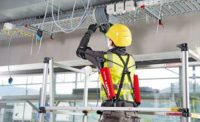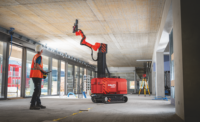Mechanical Exoskeleton Eases Strain of Overhead Work

The Levitate Airframe transfers weight from wearers’ arms to their hips, allowing for less-strenuous overhead work.
Photo Courtesy of Levitate
Repetitive overhead tasks are rough on the back and shoulders and can result in stress injuries over time. Finding more ergonomic ways to do these tasks is not always an option, and jobs such as fire-suppression system installations and other MEP operations require extensive overhead work.
While some companies have exoskeletons designed to improve lifting, Levitate’s Airframe exoskeleton is designed for overhead work.
“In the construction industry, or any industry, we don’t claim every job requires this Airframe,” says Joseph Zawaideh, vice president of marketing and business development at Levitate. “But for shoulder-level or overhead work in construction, this will support the workers’ arms and reduce fatigue and have a healthier worker at the end of the day.”
The Airframe is a mechanical exoskeleton that uses an aluminum frame to transfer the weight of the wearer’s arms down from the shoulders to the outside of the hips, more evenly distributing the load. Because it relies on a system of pulleys to transfer the weight, the exoskeleton does not require a power source.
“Imagine you are working over your head, and as you reach someone puts a shelf right under your elbow for support, and when you lower your arm it gets out of the way,” says Zawaideh. “It lets you do the job you need to do, and hopefully prevents injury.” The lightweight frame is sized to the wearer and is designed to not interfere with movement or other safety gear.
The Airframe has been available since late 2017, but is primarily used in the manufacturing sector, including automobile and aerospace plants. While those are more controlled environments, Zawaideh sees potential for the Airframe in the construction industry. “[In construction] there’s a lot of overhead work, and sometimes you’re holding tools that can weigh 25 lb. It’s good to get that load off of the shoulders, spine and neck.”
Mechanical and electrical contractor Emcor Group has been running trials of the Airframe, and so far the reviews have been positive. "“EMCOR employees have used the Levitate Airframe when performing overhead tasks such as installing anchors, hangars, and pipes—and while drilling. Our welders have also used it while fabricating pipe," says Michael Nahas, director, productivity and quality control at EMCOR. "“In after-task surveys completed by employees who have used the Levitate Airframe, many of them have indicated that the device does indeed make overhead and fabrication tasks easier.”"
Not every application calls for the exoskeleton, and Levitate recommends not using it in confined spaces. While the Airframe is less bulky that earlier exoskeletons, it still takes up space. But in certain cases, Zawaideh says it’s a good fit. “If you’re making the same weld over and over again, you’ll appreciate it.” Each Airframe is available for $5,000, with discounts for bulk orders.




